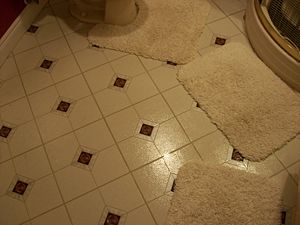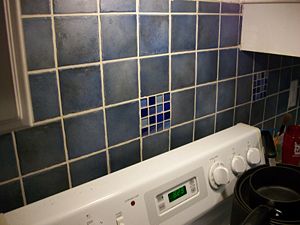Handyman
A handyman, increasingly known as a handyperson or handywoman, is a person skilled at a wide range of repairs, typically around the home. These tasks include trade skills, repair work, maintenance work, both interior and exterior, and are sometimes described as "odd jobs", "fix-up tasks", and include light plumbing jobs such as fixing a leaky toilet or light electric jobs such as changing a light fixture.
Handyman projects
The term handyman increasingly describes a paid worker, but it also includes non-paid homeowners or do-it-yourselfers. Tasks range from minor to major, from unskilled to highly skilled, and include painting, drywall repair, remodeling, minor plumbing work, minor electrical work, and furniture assembly (see more complete list below.) The term handyman is occasionally applied as an adjective to describe politicians or business leaders who make substantial organizational changes, such as overhauling a business structure or administrative division.[1][2] In the past, handypersons have usually been men, and home repair tasks have been seen as a male-oriented activity, but handywomen are becoming more prevalent as well as women using the term handypersons to describe themselves.
Many people can do common household repairs. There are resources on the Internet, as well as do-it-yourself guide books,[3] with instructions about how to complete a wide range of projects. Sometimes the fix-it skill is seen as genetic, and people lacking such skills are said to "lack the handy-man gene."[4] One trend is that fewer homeowners are inclined to do fix-up jobs, perhaps because of time constraints, perhaps because of lack of interest; one reporter commented "my family's fix-it gene petered out before it reached my generation."[5] A primary rule for all do-it-yourself repair work is focus entirely on one thing at a time.
A plumber told me once to ONLY focus on one thing at a time; this was the cardinal rule of all repairwork he said; trying to do two things simultaneously leads to problems, mistakes, injuries.[6]
For example, focus on getting a nail; then focus on hammering the nail; but don't try to do both tasks simultaneously. In this manner, injuries and mistakes are avoided.
Generally the job of paid handyman is low status, a semi-skilled labor job. It's a less prestigious occupation than a specialist such as a plumber, electrician, or carpenter. At the same time, unpaid homeowners skilled at repairs are valued for saving money. The only full-time handymen who achieve recognition are ones who do something else better, such as being an artist or writer or charismatic religious figure such as Jesus, (who was a carpenter).[7] And handyman tools sometimes become useful in different places: for example, when a proper neurological drill was not available, an Australian doctor used a handyman's drill in 2009 to open a hole in the head of a 13-year old boy to relieve pressure after a brain injury; the boy's life was saved.[8]
New tools are becoming increasingly available; there is a trend for more powerful tools which cost less money. For example, an inspection camera in a long rigid wire allows users to see inside pipes up to 100 feet in length, to look for obstructions or clogs in plumbing lines.[9] The Internet makes a wealth of fix-up information available widely to all kinds of users; so a web-based search can help a homeowner find helpful advice on a wide variety of topics including insect pest inspections and control.[10]
Handyman businesses
Market estimates
An estimate was that in 2003, the market for home-maintenance and repair spending was up 14% from 2001 to 2003.[11] Another estimate was that the market in the United States was $126 billion and was increasing by about 4% annually.[5] American homes are aging; one estimate was that in 2007, more than half of all homes are older than 25 years.[11] And, as populations worldwide tend to become older, on average, and since increasingly elderly people will be less inclined and able to maintain their homes, it is likely that demand for handyman services will grow.
Changes in entertainment and communications technology have increased demand for handymen. Installing support brackets for new wall-mounted HDTV systems has become an increasingly in-demand task for handymen. There has been a movement towards "whole-home audio systems" in which homeowners in new and existing houses can "enjoy music and radio broadcasts in any room of the house ... separate zones can be created so multiple musical selections can be played simultaneously—soothing classical in the den, talk show radio in the kitchen, and downloaded hits for the kids in the entertainment room."[12] Projects such as these typically require the expertise of handypersons.
Changes in home design can spur demand for handymen as well. There has been a trend, suffering somewhat from the recession, to use commercial or semi-commercial appliances in high-end kitchens. There has been a movement towards "disguising" household appliances, such as replacing refrigerators with models that look like built-in cabinets. And conversions such as these generate work for a wide range of kitchen contractors, including handymen.
Consumers are discovering new ways to hide their appliances, putting form and functionality on an even footing. Here are some ideas to seamlessly integrate appliances into your home, allowing you to show off your style and not your stainless steel.[13]
Disguising the appliance may involve purchasing one with a front intended to look like a cabinet, having a handyman build such a front, or, for smaller countertop appliances such as food processors, toasters, and food mixers, removing the wall covering and drywall between wall studs and building a "garage" into which the appliance slides.
Independent operators
Many towns have handymen who work part-time, for friends or family or neighbors, who are skilled in a variety of tasks. Sometimes they advertise in newspapers or online. They vary in quality, professionalism, skill level, and price. Contractors often criticize the work of previous contractors, and this practice is not limited to handymen, but to all trades.
the house painter who said that the prep work and the power washing our handyman had done would have to be done all over again; the handyman who regularly announced that none of those we had engaged (except his uncle) knew what they were doing[14]
Franchise businesses
In 2009, there were national handyman service firms which handle such nationwide tasks as public relations, marketing, advertising, and signage, but sell specific territories to franchise owners. A franchise contract typically gives a franchise owner the exclusive right to take service calls within a given geographical area. The websites of these firms put possible customers in touch with local owners, which have handypersons and trucks. Customers call the local numbers. Typically these firms charge around $100/hour, although fees vary by locality and time of year. In many parts of the world, there are professional handyman firms that do small home or commercial projects which claim possible advantages such as having workers who are insured and licensed. Their branch offices schedule service appointments for full-time and part-time handymen to visit and make repairs, and sometimes coordinate with sub-contractors.
One Lehman Brothers executive, after being let go from the Wall Street firm, bought a Union, New Jersey franchise from a national handyman firm.[15] A franchise was approximately $110,000 with a franchise fee of $14,900, according to a spokesperson for a national handyman franchise.[15]
Some see a benefit of franchising as "entrepreneurship under the safety net of a tried-and-true business umbrella"[15] but forecast a 1.2 percent decrease in franchise businesses during the 2008-2009 recession.[15] In 2005, according to a survey released by the Washington-based International Franchise Association showed 909,000 franchised establishments in the United States employing some 11 million people.[15] Franchises offer training, advertising and information technology support, lower procurement costs and access to a network of established operators.[15]
Franchise handyman firms sometimes pitch clients by asking prospective customers about their unresolved "to-do lists."[16] The firm does odd jobs, carpentry, and repairs.[16] Trends such as a "poverty of time" and a "glut of unhandy husbands" has spurred the business.[16] Technicians do a range of services including tile work, painting, and wallpapering.[16] One firm charges $88 per hour.[16] The firm targets a work category which full-fledged remodelers and contractors find unprofitable.[16] A consumer was quoted by a reporter explaining the decision to hire one firm: "'I couldn't find anyone to come in and help me because the jobs were too small', said Meg Beck of Huntington, who needed some painting and carpentry done. She turned to one franchise firm and said she liked the fact that the service has well-marked trucks and uniformed technicians and that a dispatcher called with the names of the crew before they showed up."[16] There are indications that these businesses are growing.[16] There are different firms operating.[17][18][11][19]
Other competitors include online referral services.[5] In addition, some large home centers offer installation services for products such as cabinets and carpet installation.[16] Sometimes homeowners contact a professional service after trying, but failing, to do repair work themselves; in one instance, a Minneapolis homeowner attempted a project but called a technician to finish the project, and the overall cost was substantial.[20]
Handymen businesses seem to be increasingly prevalent. One handyman advised others about how to run a successfuly handyman business with basic pointers (1) return phone calls (2) show up when promised (3) do quality work (4) keep homeowners place clean (5) guarantee your work.[21]
| “ | By doing those three things I made myself stand out from the competition. I can’t tell you the number of times I’ve had people tell me I was the only person who called them back or I was the only person who would even show up to give them an estimate.[22] | ” |
One factor that hinders handymen is a general perception by homeowners that home repair contractors are untrustworthy. One survey by the Gallup Poll in the United States found that construction contractors ranked 19th out of 32 occupations on a scale of trustworthiness, and only 23% of the public saying that the industry was "trustworthy." Common complaints about contractors were "failure to finish the job" and "poor quality of work".[23] During the real estate boom during the middle years of the first decade of the 21st century, demand for construction and repairwork was substantial, and the proportion of contractors who did lesser quality work or worked unethically was greater.
Assessment of Handyman Options
How well do the franchise chains perform? One Wall Street Journal reporting team did an informal assessment by hiring "handymen all over the country and asked them to fix a wide range of problems, from a relatively routine leaky faucet to a sticky door."[11] The reporter concluded that "with few licensing requirements and standards for the industry, prices are all over the board."[11] One quote was ten times as large as another.[11] Further, the reporter concluded "A big corporate name is no guarantee of quality or speedy service."[11] One corporate firm took three weeks to fix a stuck door.[11] Service varied from spotty to good, with complaints about unreturned phone calls, service people standing on dining room chairs, leaving holes between wood planking, but liked getting multiple jobs done instead of just one.[11] Customers liked handymen wearing hospital booties (to avoid tracking dirt in houses).[11] The reporter chronicled one experience with repairing a water-damaged ceiling. A franchise firm fixed it for $1,530; a second (non-franchise local handyman) fixed a similar ceiling for $125.[11] The reporter prefered the second worker, despite the fact that he "doesn't have a fancy van -- or carry proof of insurance."[11] Tips for selecting a good handyman include: ask questions, get written estimates on company stationery, make sure handymen guarantee their work, pay with credit cards or checks because this provides an additional record of each transaction, check references and licenses, and review feedback about the contractors from Internet sites.[24]
Tools
What tools do most handymen have? One source suggested the most necessary tools were these: hammer, saw, stapler, screwdrivers, drill with bits, level, clamps, pliers, wrench, tape measure (25 feet length is preferred), utility knife,flashlight, toilet plunger.[25] Basic supplies include tape (electrical tape and duct tape), various glues, spackle, fasteners, sandpaper, and lubricants. A tool box to put them in helps keep them organized. A screwdriver set which includes both the traditional flat blade bits as well as Phillips (four sided) will handle most tasks.
Powered tools greatly increase speed and efficiency. They're more expensive, but can accomplish a wide variety of tasks quickly. In the past hundred years, circular saws, powered drills, and other tools augmented with electric power have greatly increased the capability of handymen to get tasks done efficiently and safely. A powered drill-driver with a reversible function is highly recommended; it's better than non-powered screwdrivers since it handles multiple tasks. In addition, drill bits and screw heads can be interchanged in a few seconds for flexibility with most models. It is often efficient, however, to have several drill-drivers at hand rather than constantly changing the bit in a single tool, when, for example, it is necessary to drill screw holes and then drive and possibly countersink the screw.
Cordless power tools with rechargeable batteries allow increased mobility since they reduce fuss with electric cords, although batteries are expensive and degrade over time. Newer rechargeable batteries made of lithium promise to make batteries retain charges longer. Handymen using corded models should get a long (25 foot) extension cord with multiple outlets, so prevent having to keep switching plugs around. An organizing see-through box with a generous assortment of differing sizes of screws and nails can save repeated trips to a store. A powered circular saw can handle a wide variety of cutting tasks. While a hand-held level will meet most needs, consider some of the newer laser-light levels which can project a thin red line across a wide surface and eliminate a need for chalk lines. A powered vibrating sander can be a terrific tool; consider a lightweight model with a tip to get into small spaces.
Legal issues
Generally, in the United States, there are few legal issues if an unpaid homeowner works on a project within their own home, with some exceptions. Some jurisdictions require paid handypeople to be licensed and/or insured. New Jersey, for example, requires all handymen who work in for-profit businesses serving residential and commercial customers, to be registered and insured.[26] Often handymen are barred from major plumbing, electrical wiring, or gas-fitting projects for safety reasons, and authorities sometimes require workers to be licensed in particular trades. However, minor plumbing work such as fixing water taps, connecting sinks, fixing leaks, or installing new washing machines, are usually permitted to be done without licensing. Many handymen are insured under a property damage liability policy, so that accidental property damage from negligence or accidents are covered.
Handymen in popular culture
The handyman image recurs in popular culture. There have been songs about handymen recorded by Elvis Presley in 1964, Del Shannon in 1964, James Taylor in 1977.[27] There are femme-fatale TV characters who fall for handymen.[28] Handymen have been portrayed in books and films, generally positively, as do-gooder helpful types, but not particularly smart or ambitious. In a book by author Carolyn See called The Handyman, a handyman is really an aspiring but discouraged artist who transforms the lives of people he works for, as well as sleeping with some of his clients, and his experiences improve his artistic output.[7] The book suggests handymen discover "the appalling loneliness of the women who call him for help" whose needs are sometimes "comic," sometimes "heartbreaking," and deep down "sexual."[29] A 1980 movie called The Handyman was about a carpenter-plumber who was "good at what he does" but is "too honest and trusting", and gets taken advantage of by "women who find him handsome and understanding;" the movie earned negative reviews from critic Vincent Canby.[30] Other movies have used a rather tired formula of sexy-handyman meets bored-housewives, such as The Ups and Downs of a Handyman, a 1975 movie in which "Handsome Bob also finds he's a fast favorite with the local housewives, who seem to have more than small repairs on their minds."[31] In Canada, there's a television show called Canada's Worst Handyman which is a reality-show in which contestants work hard not to become labeled as the worst handyman. Home Improvement was an American television sitcom starring Tim Allen, which aired 1991 to 1999.
References
- ↑ Paul Lewis. MAN IN THE NEWS; Diplomatic Handyman: Diego Cordovez, New York Times, April 16, 1988. Retrieved on 2009-10-26.
- ↑ Religion: Handyman to Washington, Time Magazine, Apr. 13, 1936. Retrieved on 2009-10-26.
- ↑ LIESL SCHILLINGER. Fire the Handyman, Then Do It Yourself (book reviews), New York Times: Fashion & Style, November 27, 2005. Retrieved on 2009-10-26. “HELP, IT'S BROKEN! A Fix-It Bible for the Repair-Impaired. By Arianne Cohen; READYMADE: How to Make (Almost) Everything: A Do-It-Yourself Primer. By Shoshana Berger and Grace Hawthorne.”
- ↑ Kim O'Donnel. The Case of the Kitchen Barrel Nuts, Washington Post, March 26, 2007. Retrieved on 2009-10-26.
- ↑ 5.0 5.1 5.2 Michelle Slatalla. ONLINE SHOPPER; $220 for Two Hours? Clocking Mr. Fix-It, New York Times, August 5, 2004. Retrieved on 2009-10-17.
- ↑ Anonymous plumber. "Spoken advice", 'Anonymous plumber', 2007. Retrieved on 2009-12-01.
- ↑ 7.0 7.1 Elizabeth Gleicke. Books: The Handyman By Carolyn See, 'Time Magazine', Apr. 12, 1999. Retrieved on 2009-10-26.
Cite error: Invalid
<ref>tag; name "tws26oct03" defined multiple times with different content - ↑ Steve Marshall (Australia). Handyman drill saves blood-clot victim, USA Today, May 20, 2009. Retrieved on 2009-12-08.
- ↑ SeeSnake® microReel Inspection Camera System. Ridgid (2010-02-21). Retrieved on 2010-02-21.
- ↑ Jerry Alonzy (2010-02-21). Home Pest Control... What You Can Do To Take Back Your Home!. The Natural Handyman. Retrieved on 2010-02-21.
- ↑ 11.00 11.01 11.02 11.03 11.04 11.05 11.06 11.07 11.08 11.09 11.10 11.11 Danielle Reed. [http://homes.wsj.com/buildimprove/20030429-reed.html Chains Take a Stab At Handyman Work], Wall Street Journal, April 29, 2003. Retrieved on 2009-10-26.
- ↑ Choosing a Whole-Home Audio System. bobvila.com (2010-02-21). Retrieved on 2010-02-21.
- ↑ Disguise Your Appliances. bobvila.com (2010-02-21). Retrieved on 2010-02-21.
- ↑ Who Did This To You?, New York Times: Opinion, May 7, 2006. Retrieved on 2009-10-26.
- ↑ 15.0 15.1 15.2 15.3 15.4 15.5 Deborah L. Cohen. Franchising heats up as economy cools down, Reuters, Feb 24, 2009. Retrieved on 2009-10-17.
- ↑ 16.0 16.1 16.2 16.3 16.4 16.5 16.6 16.7 16.8 PAULA GANZI LICATA. WHERE WE LIVE; They Make House Calls: The Range of Services Grows, New York Times, April 3, 2005. Retrieved on 2009-10-17.
- ↑ Handyman Matters., Handyman Matters website, 2009-10-26. Retrieved on 2009-10-26.
- ↑ Mr. Handyman, Mr. Handyman website, 2009-10-26. Retrieved on 2009-10-26.
- ↑ Jayne O'Donnell. Rent-A-Husband handyman service raises questions, USA TODAY, 2009-10-21. Retrieved on 2009-10-26.
- ↑ SUSAN SAULNY. Even to Save Cash, Don’t Try This Stuff at Home, New York Times, May 16, 2009. Retrieved on 2009-10-17.
- ↑ Patrick Cash (2010-02-21). Thinking About Starting A Handyman Business?. Handyman-Business.com. Retrieved on 2010-02-21.
- ↑ Patrick Cash (2010-02-21). Thinking About Starting A Handyman Business?. Handyman-Business.com. Retrieved on 2010-02-21.
- ↑ Contractors Viewed as Untrustworthy. The Natural Handyman (2010-02-21). Retrieved on 2010-02-21.
- ↑ Joel Bell. The Nuts and Bolts of Choosing a Handyman, Reuters, Sep 9, 2009. Retrieved on 2009-10-26.
- ↑ Handy Tolls. Super Handyman (2010-02-21). Retrieved on 2010-02-21.
- ↑ Starting a Business in NJ, State of New Jersey: Department of the Treasury, 2008-11-11. Retrieved on 2009-10-27.
- ↑ BEN SISARIO. Lost Elvis Song Turns Up, New York Times, August 21, 2003. Retrieved on 2009-10-26.
- ↑ Mary McNamara. Review: 'Maneater' -- Jennifer (Marla Sokoloff), the sweet-faced rich girl who has the hots for her handyman., Los Angeles Times, May 29, 2009. Retrieved on 2009-10-26.
- ↑ DAVID WILLIS McCULLOUGH. Home Improvement -- Carolyn See's handyman hero can manage the tasks that matter most., New York Times: Books, March 21, 1999. Retrieved on 2009-10-26.
- ↑ Vincent Canby. Movie Review -- The Handyman (1980), New York Times, September 27, 1980. Retrieved on 2009-10-26.
- ↑ The Ups and Downs of a Handyman (1975) movie review; alternate title: The Happy Housewives, New York Times, 1975. Retrieved on 2009-10-26.





